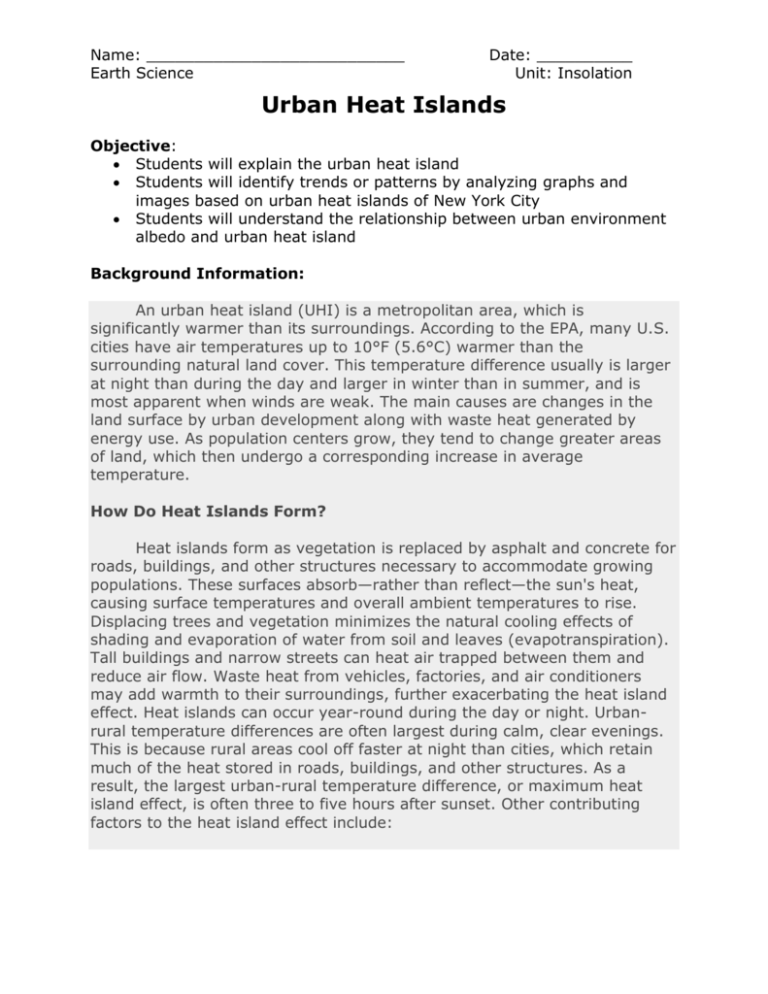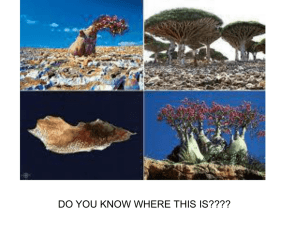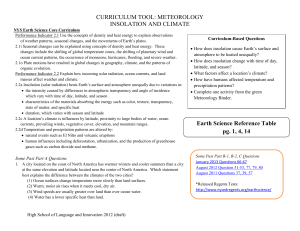Urban Heat Islands - UCAR Center for Science Education
advertisement

Name: ___________________________ Earth Science Date: __________ Unit: Insolation Urban Heat Islands Objective: Students will explain the urban heat island Students will identify trends or patterns by analyzing graphs and images based on urban heat islands of New York City Students will understand the relationship between urban environment albedo and urban heat island Background Information: An urban heat island (UHI) is a metropolitan area, which is significantly warmer than its surroundings. According to the EPA, many U.S. cities have air temperatures up to 10°F (5.6°C) warmer than the surrounding natural land cover. This temperature difference usually is larger at night than during the day and larger in winter than in summer, and is most apparent when winds are weak. The main causes are changes in the land surface by urban development along with waste heat generated by energy use. As population centers grow, they tend to change greater areas of land, which then undergo a corresponding increase in average temperature. How Do Heat Islands Form? Heat islands form as vegetation is replaced by asphalt and concrete for roads, buildings, and other structures necessary to accommodate growing populations. These surfaces absorb—rather than reflect—the sun's heat, causing surface temperatures and overall ambient temperatures to rise. Displacing trees and vegetation minimizes the natural cooling effects of shading and evaporation of water from soil and leaves (evapotranspiration). Tall buildings and narrow streets can heat air trapped between them and reduce air flow. Waste heat from vehicles, factories, and air conditioners may add warmth to their surroundings, further exacerbating the heat island effect. Heat islands can occur year-round during the day or night. Urbanrural temperature differences are often largest during calm, clear evenings. This is because rural areas cool off faster at night than cities, which retain much of the heat stored in roads, buildings, and other structures. As a result, the largest urban-rural temperature difference, or maximum heat island effect, is often three to five hours after sunset. Other contributing factors to the heat island effect include: Name: ___________________________ Earth Science Date: __________ Unit: Insolation Size and shape of cities—aerodynamically, cities have a very different shape than rural areas. Tall buildings act as obstacles and reduce wind speeds. Urban deserts—cities can be thought of as virtual deserts with almost no vegetation and materials that are almost completely impermeable to rain. This combination leads to a lack of evapotranspiration, which increases sensible heat. Urban canyons—the tall canyons formed by city buildings trap radiant energy in their walls. Comparisons of this "canyon effect" in European and North American cities suggest that areas with denser and taller buildings will more rapidly develop heat islands. Humidity effects—although there is little difference in the amount of water that cities and countrysides retain in their atmospheres (absolute humidity), the higher urban temperatures effectively lowers the relative humidity (since warm air can hold more water than cold air). Urban haze—The haze of air pollution that hangs over many cities can act as a miniature greenhouse layer, preventing outgoing thermal radiation (heat) from escaping from urban areas. Anthropogenic heat—The release of heat from the burning of fossil fuels can also raise urban temperatures. On a typical winter day, Manhattan releases four times more energy from burning fossil fuels than the amount of energy that comes into the urban area from the Sun. Are Heat Islands and Global Warming Related? Heat islands describe local-scale temperature differences, generally between urban and rural areas. In contrast, global warming refers to a gradual rise of the earth's surface temperature. While they are distinct phenomena, summertime heat islands may contribute to global warming by increasing demand for air conditioning, which results in additional power plant emissions of heat-trapping greenhouse gases. Strategies to reduce heat islands, therefore, can also reduce the emissions that contribute to global warming. The heat island effect can also complicate studies of longterm trends. By accurately measuring heat islands, scientists can remove the heat island effect from global temperature records. Standards New York State 2.1a Earth systems have internal and external sources of energy, both of which create heat. 2.1b The transfer of heat energy within the atmosphere, the hydrosphere, and Earth’s interior results in the formation of regions of different densities. These density differences result in motion. 2.2a Insolation (solar radiation) heats Earth’s surface and atmosphere unequally due to variations in characteristics of the materials absorbing the energy such as color, texture, transparency, state of matter, and specific heat. Name: ___________________________ Earth Science Date: __________ Unit: Insolation Use the picture above to place them items in order of albedo. The first one has been done for you. Urban Material 1. White paint 2. 3. 4. 5. 6. 7. 8. 9. 10. Albedo 0.50 – 0.90 Name: ___________________________ Earth Science Date: __________ Unit: Insolation Procedures 1. Make a hypothesis about what area of New York City would have the highest nighttime surface temperatures. Provide a scientific explanation for you hypothesis. Problem: Which location in New York City would have the highest nighttime temperatures? Hypothesis: Name: ___________________________ Earth Science Date: __________ Unit: Insolation 2. Compare the Landsat images on surface temperature for NYC for July, August, and September. Name: ___________________________ Earth Science Date: __________ Unit: Insolation 3. Record your observations. What patterns do you notice? Which month is the hottest? How do you know? What two variables did they keep the same in taking the satellite image of New York City? Name: ___________________________ Earth Science Date: __________ Unit: Insolation Observations: What are the top three building types that use the most energy during a heat wave? 1. 2. 3. Name: ___________________________ Earth Science Date: __________ Unit: Insolation Observation: What do you notice about the graph? Which area seems to be the coolest? Why? Observation: What do you notice about the graph? Which area seems to be the coolest? Why? Name: ___________________________ Earth Science Date: __________ Unit: Insolation Analysis and Conclusion 1. What is an Urban Heat Island? What is the main cause of a UHI? _____________________________________________________________ _____________________________________________________________ _____________________________________________________________ _____________________________________________________________ _____________________________________________________________ 2. Where does waste heat come from? _____________________________________________________________ _____________________________________________________________ 3. When is the maximum heat island effect? _____________________________________________________________ _____________________________________________________________ 4. Describe how humidity affects UHI? _____________________________________________________________ _____________________________________________________________ 5. Using the diagram from the Various Urban Environment Albedos, what urban material absorbs the most heat energy? _____________________________________________________________ 6. If June 21 is the summer solstice, then why is it hottest in August and not in June? _____________________________________________________________ _____________________________________________________________ Name: ___________________________ Earth Science Date: __________ Unit: Insolation 7. Why do scientist need to look at energy consumption on days of extreme heat? _____________________________________________________________ _____________________________________________________________ 8. Why do scientists use the surface temperature of Central Park to understand the Urban Heat Island? _____________________________________________________________ _____________________________________________________________ Links 1. Skin of the Big Apple: Characterizing the Surface Heat Island of New York City http://www.epa.gov/hiri/resources/pdf/SurfaceUHI_EPA4.pdf 2. Variations in New York city’s urban heat island strength over time and space http://pubs.giss.nasa.gov/docs/2008/2008_Gaffin_etal.pdf









